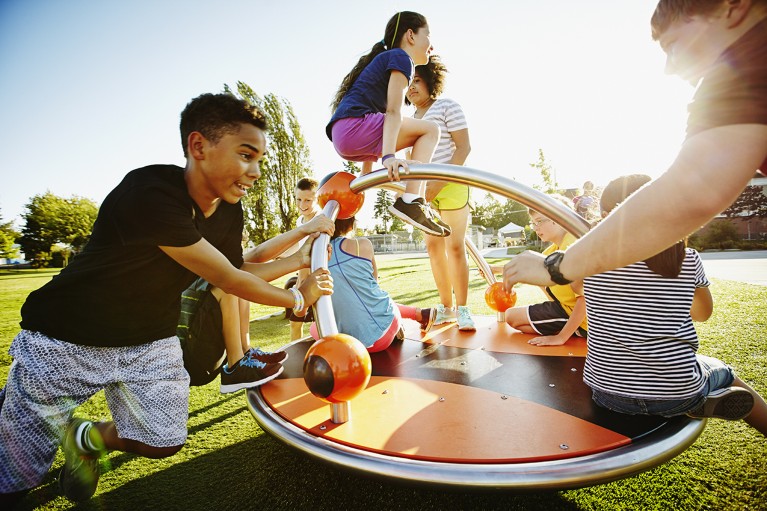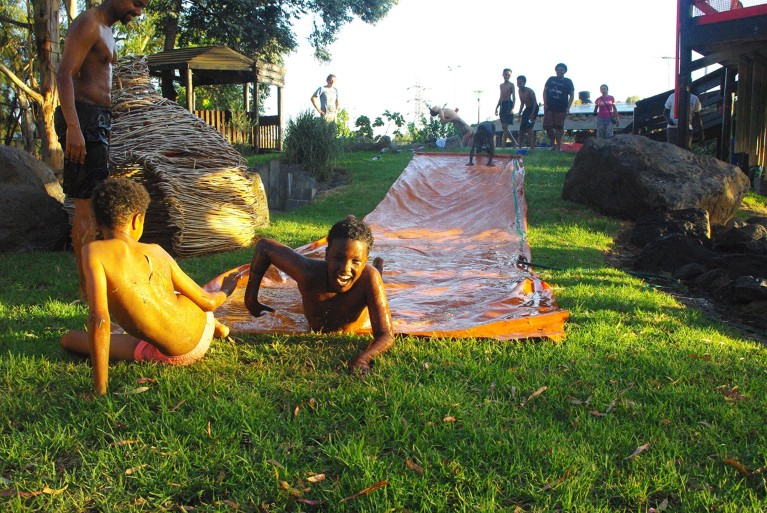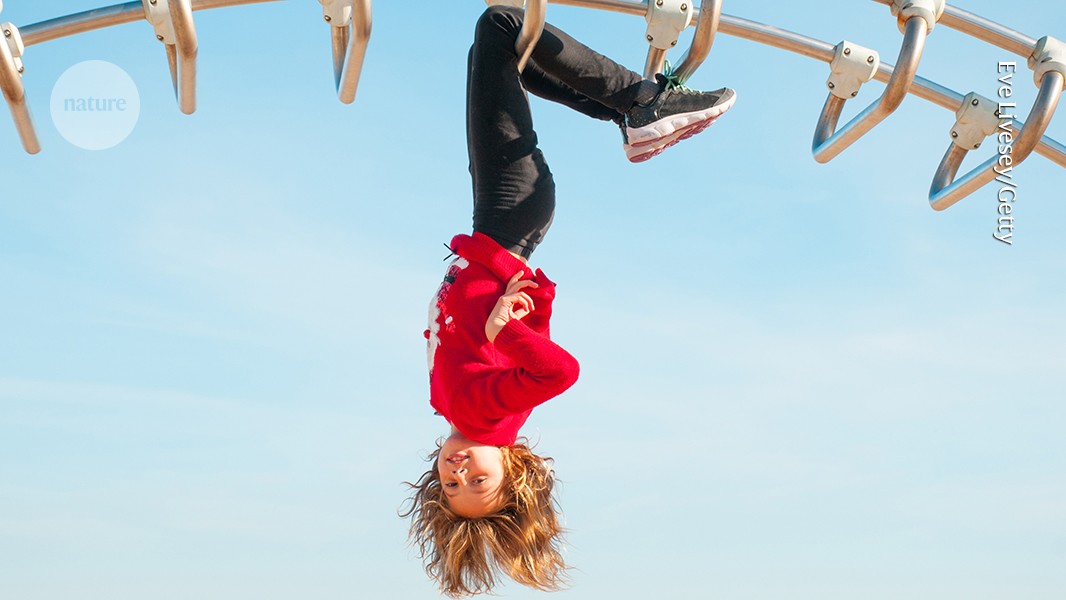On a warm, sunny beach near Melbourne, Australia, Alethea Jerebine watched her daughters scrambling up a jumble of rocks. “Can they do that?” she worried about her 10-year-old and 13-year-old. The rocks were pocked with crevices and so steep that they gave Jerebine vertigo. Instinctively, she wanted to tell them to stop.
At the same time, she knew her pangs of anxiety were incongruous with her own research. What her children were doing is a kind of ‘risky play’ — activities ranging from climbing and jumping from heights to simply leaving the watchful eye of an adult. Jerebine is a public-health and psychology researcher at Deakin University in Melbourne, who studies the wide-ranging benefits of risky play. Still, she’s not immune to the pressure that many parents and guardians feel to protect their children from every possible harm.
Governments are banning kids from social media: will that protect them from harm?
Over the past two decades, research has emerged showing that opportunities for risky play are crucial for healthy physical, mental and emotional development. Children need these opportunities to develop spatial awareness, coordination, tolerance of uncertainty and confidence.
Despite this, in many nations risky play is now more restricted than ever, thanks to misconceptions about risk and a general undervaluing of its benefits. Research shows that children know more about their own abilities than adults might think, and some environments designed for risky play point the way forwards. Many researchers think that there’s more to learn about the benefits, but because play is inherently free-form, it has been logistically difficult to study. Now, scientists are using innovative approaches, including virtual reality, to probe the benefits of risky play, and how to promote it.
Even safety advocates support it. “Most people assume I would be against risky play,” says Pamela Fuselli, president of Parachute, an injury-prevention non-profit organization based in Toronto, Canada. “But the benefits are so broad in terms of social, physical, mental development and mental health, I don’t think we can underestimate the value.”
Thrilling and exciting
The origins of risky-play research date back to 1996, when Norway passed a regulation on playground safety that required things such as handrails, rounded corners and equipment that minimizes the risk of injury from falls to be added to play areas. A few years later, psychologist Ellen Sandseter noticed that playground equipment was being removed as a result of the law and replaced with elements that offered little chance for risk-taking. She found this concerning. Her research had shown that adolescents who had fewer opportunities for positive types of thrill-seeking — such as mountain climbing — were more likely to take negative risks, such as shoplifting1. So, Sandseter, who works at Queen Maud University College of Early Childhood Education in Trondheim, Norway, began to study risk-seeking and sensation-seeking in children aged three to five. Unable to find a definition of risky play in the literature at the time, she built one on the basis of hours of observation and interviews with young children about what activities they thought were scary, risky or thrilling.
Her definition of risky play is still widely used: thrilling and exciting play that involves uncertainty and a risk — either real or perceived — of physical injury or getting lost.

Risky play is thought to help build risk-management skills that can transfer to other situations.Credit: Thomas Barwick/Getty
Importantly, risk is not the same as danger. Danger is something a child isn’t equipped to notice or deal with. For example, it’s dangerous, not risky, for four-year-olds to go barefoot around broken glass or to cross a busy street with no practice. Risk changes with age and doesn’t always include things that look risky to adults. For a one-year-old who has never walked before, taking a single step is probably risky enough.
The goal of promoting risky play isn’t to turn cautious children into thrill-seekers, it’s simply to allow them to take incremental risks at whatever pace they choose, say proponents. “What risky play looks like for one child will be totally different to what it looks like for another,” says child psychologist Helen Dodd at the University of Exeter, UK.
And getting chances to take risks is as important for children with naturally cautious personalities as it is for those who are born daredevils. “All children need to be able to stretch their own limits, and all children want that,” says Sandseter.
Risk management
Risky play is associated with greater resilience, self-confidence, problem-solving and social skills such as cooperation, negotiation and empathy, according to studies by Sandseter and others. When a study in Leuven, Belgium, gave four- and six-year-olds just two hours a week of opportunities for risky play over the course of three months, their risk-assessment skills improved compared with those of children in a control group2. In this study, the risky play took place at school, in a gym class and in the classroom.
Young people’s mental health is finally getting the attention it needs
Outdoor risky play might have extra benefits. It is linked to having low levels of stress and anxiety. Dodd hypothesizes that risky play lowers children’s risk of anxiety by teaching them about physiological arousal, the adrenaline and racing heartbeat that accompanies anxiety and excitement. Over time, her theory posits, when children have a chance to repeatedly experience the cycle of challenge, arousal and coping, this helps them learn to manage anxiety and understand that physiological stress isn’t a disaster and doesn’t last forever.
Dodd had set up an observational study3 to test this theory. It began in early April 2020 and captured data during the first month of the COVID-19 lockdown in the United Kingdom. Dodd found that children who spent more time playing adventurously had fewer signs of anxiety and depression (according to parent reports) than those who spent less time in adventurous play. The kids with more opportunities for risk seemed happier. This pattern of risky play as a protective factor against mental-health issues was stronger for children from lower-income households than for those from higher-income households.
As a whole, the quality of research in the field of risky play is mixed, says child-development researcher Mariana Brussoni at the University of British Columbia in Vancouver, Canada, but often with good reason. Not many studies are gold-standard randomized controlled trials, but these “are expensive and sometimes inappropriate to the research question”, she says.
None of this means that parents should tell kids to take more risks, says Dodd, because that doesn’t lead to positive learning. “Play should always be led by the child and what the child wants to do,” she says. The adults’ role is to provide a conducive environment and then get out of the way — or at the most, to cheerlead gently. This makes risky play hard to study experimentally. “It ceases to be play the moment an adult tells a child to do it,” says Dodd.

The Venny, an adventure playground in Melbourne, Australia, provides opportunities for risky play.Credit: The Venny
If risky-play advocates have a rallying cry, it is probably this: “Children should be as safe as necessary, not as safe as possible.” But what’s a parent to do with this injunction? A child’s facial expressions and body language can be good markers to observe. A study4 led by Brussoni contains a table that the team used to sort positive risky play from hazardous or dangerous play as they observed children. When kids are in the productive risky-play zone and trying things that are above their current skill level, they might have an expression of determination on their face, seem in control of their body and use trial and error. If that’s the case, Dodd suggests nearby adults to “just hold back that little bit more, count to ten before you say ‘no’. See if they can resolve something for themselves rather than always jumping in.”
The topography of a playground can also encourage risky play, research shows4. Play on uneven surfaces — such as boulders — or steep slopes was much more likely to involve positive-risk behaviours than play on flat areas in Brussoni’s 2023 analysis4 at a play space with nature elements at the Santa Barbara Museum of Natural History in California.
Virtual rock-hopping
One of Brussoni’s hypotheses about risky play is that it can help to build risk-management skills that transfer to other situations, such as crossing a busy street, she says. That’s hard to test. “Ethically speaking, you can’t really throw kids in traffic environments, because they could actually get hurt,” she says. So Brussoni, Sandseter and their colleagues created a virtual setting in which they could convincingly test children’s risk-management skills, without the danger.
First, they gave children aged seven to ten eye-tracking virtual-reality headsets and fitted motion sensors on their joints. The kids were able to explore three scenarios: crossing a street, leaping from rock to rock to cross a river and roaming a virtual playground to balance on the equipment.




